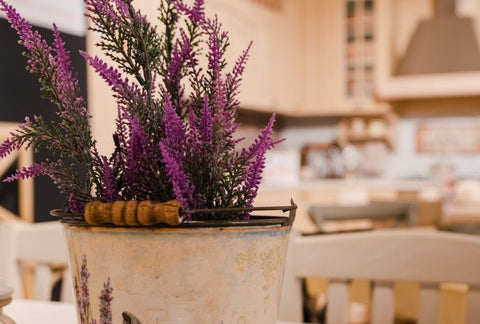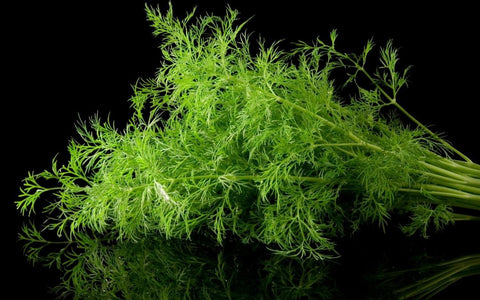Lavender is more than just a nice smelling plant – it’s been investigated for its ability to help improve sleep, ease pain, and reduce blood pressure.

Timing
Sprouts in 2-3 weeks. Harvest from Year 1+ on.

Full Sun
Equivalent of 6+ hours of direct sun [DLI of 18+ mol/m²/day].

Care
Beginner-friendly. You’ll sprout, thin, prune, and harvest.
Best Lavender Varieties to Grow Inside
The lavender plant has many uses, especially for helping to relieve anxiety, stress, and insomnia. We picked out 4 of the best lavender varieties to grow indoors:
Canary Island
This is a compact shrub with silvery foliage with a fuzzy appearance. Rewarding and easy to grow.
Clayton FarmFern-leaf
This Lavender looks very nice when planting in containers on patios and decks. Aromatic lacy foliage makes nice filler material for cut-flower bouquets.
Renee’s GardenFrench
Its scent is used more for its aromatic properties and considered good in cleaning products and products designed to freshen your home.
French.orgAnouk
Easy to grow, it’s drought tolerant once established. Its calming fragrance is a soothing stress reliever.
American MeadowsBest Setup for Lavender Plants
You’ll need:
Planter:
Ceramic Self Watering Planter (preferred) or pot that is at least 12″ / 5 gal.
Soil:
Free-Draining Mix
Plant Food:
At the start: Balanced Blend. This should be equal parts nitrogen, phosphorus, and potassium (with NPK numbers like 10-10-10).
Ongoing: Herb Blend. This should be high in nitrogen (with NPK numbers like 10-5-5).
Grow Light:
A strong grow light that can give the equivalent of 6+ hours of direct sun [DLI of 18+ mol/m²/day].
Preparing your Planter & Watering Schedule for Lavender
Lavender plants don’t do well in moist soil conditions. The roots are not accustomed to being too wet and will rot in boggy conditions. On the other hand, if the soil dries out completely the roots will die back and the plant won’t recover. This can catch you off guard because the plant’s not very expressive (its leaves don’t wilt) so it will look fine right up until it dies.
A Ceramic Self Watering Planter filled with a free-draining potting mix self-regulates to keep the soil on the drier side, but with a little consistent moisture (and means no watering guesswork for you). Careful of wick-based self-watering planters with Lavender – as they tend to be too wet.
To set one up:

- Fill up the planter with dry soil from the bag, gently tamping down the top.
- Dump the soil into a large mixing bowl and add water until the soil is moist, but not sopping wet (about ½ Cup).
- Mix in 1 tablespoon of the Balanced Blend Plant Food.
If you are using a regular pot instead, it should be a little bit bigger (at least 12″ / 5 gal) and will need drainage holes to prevent it from being overwatered. Let the top of the soil dry out between watering.
Starting your Lavender: Seed vs Cutting vs Nursery Plant
New Lavender plants can be started from seed, propagated from an established plant, or purchased live at many garden centers. We prefer to sprout from seed or propagate from a stem cutting, as it results in plants that are adapted to your growing conditions and limit the chances that you accidentally bring home pests.
How to Plant Lavender Seeds

Lavender grows quickly from seed. Plant 4 sites in a 12″ / 5 gal container. In larger containers, space sites 3″ apart. For each site, press 4 seeds into the surface. Keep the soil warm (65-80°F, ideally 70°F). Sprouts typically appear in 18 days but can be as quick as 14 days or as long as 21 days depending on your conditions.
Propagating Lavender: How to Clone from a Stem Cutting

If you’ve already got a Lavender plant you love (or a friend does!) you can easily “clone” it with just sharp scissors and a clean glass of water. First, cut a couple of 6” shoots of new growth (avoid anything woody). Next, remove the lower leaves, so the bottom half is just stem. Place in a glass of 3” of water, making sure the cut leaf spots are underwater. Place the glass on a bright windowsill and change the water every few days. In a couple of weeks, roots should emerge and you can transplant them into your container. While using additional rooting hormones won’t hurt, it’s not necessary with Lavender plants.
- Cut 6” section of new growth.
- Remove leaves halfway and place them in the water on a sunny windowsill.
- Wait 14-28 days for a few ½ inch roots to form and carefully transplant into the final container.
How to Transplant Lavender
%20and%20give%20it%20a%20good%20inspection%20for%20pests.%20Leaves%20should%20be%20dark%20green%20without%20holes,%20spots,%20or%20curled%20edges.%20A%20best%20practice%20is%20to%20actually%20%E2%80%9Cquarantine%E2%80%9D%20your%20plant%20for%20about%20a%20week%20after%20bringing%20it%20home%20to%20make%20sure%20it%E2%80%99s%20free%20and%20clear%20of%20ride-on%20pests.</p>%0A<p>Ensuring%20it%E2%80%99s%20pest%20and%20disease-free%20it%E2%80%99s%20time%20to%20transplant%20your%20seedling%20into%20its%20final%20home.</p>%0A<ol>%0A%20%20<li>Remove%20some%20soil%20from%20its%20final%20planter%20%E2%80%93%20leaving%20enough%20space%20for%20the%20bottom%20of%20the%20seedling%20to%20be%20just%20higher%20than%20the%20soil%20surface.</li>%0A%20%20<li>Hold%20on%20to%20the%20base%20of%20the%20stem%20with%20one%20hand,%20and%20turn%20the%20pot%20over%20while%20gently%20pulling%20the%20seedling.%20Giving%20the%20pot%20a%20few%20squeezes%20can%20help%20dislodge%20it.</li>%0A%20%20<li>Place%20in%20its%20final%20container%20and%20fill%20around%20it%20with%20soil%20so%20that%20it%E2%80%99s%20tight,%20but%20not%20compacted.</li>%0A</ol>%0A%0A<h3>Where%20to%20Grow%20Your%20Lavender%20Plants</h3>%0A<p>While%20you%20should%20take%20advantage%20of%20the%20sun%20(it%E2%80%99s%20free%20and%20perfect%20for%20plants)%20there%20are%20limited%20circumstances%20where%20indoor%20natural%20light%20is%20enough%20for%20Lavender%20plants%20to%20grow%20well.%20A%20very%20bright%20window%20can%20cut%20your%20grow%20light%20needs%20in%20half,%20but%20if%20you%20want%20to%20grow%20lots%20of%20Lavender,%20you%E2%80%99ll%20still%20need%20one.%20For%20an%20introduction%20to%20grow%20lights,%20head%20over%20to%20our%20post%20<a%20href=)

How Bright Should Your Grow Light Be?
Lavender plants need the equivalent of 6+ hours of direct sunlight [DLI of 18+ mol/m²/day] to grow their best. In order to provide an equivalent amount with a grow light, it needs to be pretty bright! The 24W Sansi bulb should be placed 6 inches away from the top of the plant. This will give your PPFD (the standard measure of brightness) of 500 μmol/m²/s.
How Many Hours Per Day Do Your Lavender Plants Need Under a Grow Light?
Lavender plants are known as “long-day”. When they sense over 12 hours of light per day, they’ll start the end of their lifecycle and work on making seeds. We want to keep them in an earlier stage so we can keep harvesting the leaves, so we recommend setting up a timer to leave it on for only 10 hours per day.
Lavender Plants Grow Faster in Warmer Temps
Lavender plants are called “warm-weather crops” and will speed up their metabolism when temperatures are warmer. On the other hand, if things get too hot they’ll wilt and become prone to disease. Ideal temperatures are around 70°F but anything between 65 and 90°F grows well.
Week 2-3: Check for Sprouts
You could see seedlings in as little as 14 days (though 18 days is more typical). If it’s been 21 days and you still don’t have any sprouts, it’s likely that your setup is too cold.
Week 5: Thin Your Seedlings

Thin your planter to only have 1 seedling per site – leaving the largest plant. If you are using the recommended planter (at least 12″ / 5 gal) this will mean you’ve got 4 plants after thinning. By getting rid of the smaller seedlings, you’re allowing the biggest and strongest one to flourish by reducing its competition for water, food, and space.
If your seedlings are under 1 inch, stretching out, or folding over, it’s likely that they don’t have quite enough light.
Month 6: How to Prune Lavender Plants

Once your Lavender plant has 3 sets of mature leaves you’re ready for your prune. Cut off the top set of mature leaves, leaving the bottom two (it’s best to cut right above the pair of leaves you’re keeping on the plant). Once these branches grow out (and each has a few sets of their own leaves) you can cut the tip – just as you did with the main stem. At this point your plant will be fairly well shaped, so hone your inner Bonzi master and use your thinning and heading cuts to harvest and shape your herbs as you go.
Year 1+: How to Harvest Lavender
You can pick some in the first year or two, although leaving the plants alone allows them to grow and develop more.
Year 10+: End of Life
Lavender’s been known to survive for up to 15 years as long as you keep it in good lighting and soil conditions.
Shop This Blog
The right supplies can take the guesswork out of caring for your plants – and turn care from a daily to weekly routine. Through our grow tests, we’ve found these products to produce the best indoor Lavender (and also have simple maintenance). Plants are adaptable and can grow in many different conditions, so they are by no means necessary if you already have other supplies.
Best Containers for Lavender: Ceramic Self Watering Planters
Plants thrive on consistent moisture but can suffer if they’re waterlogged. A semi-porous ceramic self-regulates ideal conditions. Our favorite is the COSWIP planter. Runner up is XS Self Watering Planter by Wet Pot.
Best Soil for Lavender: Free Draining Mix
Lavender needs a drier environment – so you are better off using a free-draining cactus potting mix – we like this Organic Mix by Espoma.
Best Nutrients for Lavender: Balanced Blend followed by Herb & Lettuce Blend
Lavender likes to start with nutrients that are equal parts nitrogen, phosphorus, and potassium (with NPK numbers like 10-10-10). For this Balanced Blend we recommend: Dr Earth All Purpose
Once they are growing, it’s better to use plant food that is high in nitrogen (with NPK numbers like 10-5-5). For this Herb Blend, we recommend: Joyful Dirt All PurposeBest Light for Lavender: DIY or Soltech
There is a very small chance that you have the bright windows needed to grow these without a grow light. If you are looking for a higher-end option – we love the Aspect Light by Soltech. For a more affordable option, a DIY setup using a 24W Screw-in Bulb by Sansi with a Clamp Light and Mechanical Timer works well too. Check out our complete guide on a DIY setup for less than $40 or our buying guide for screw in bulbs.








There are no comments for this article. Be the first one to leave a message!